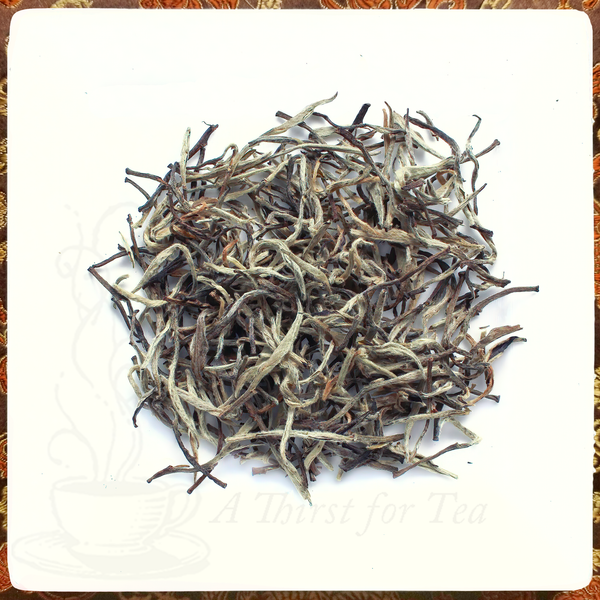Silver Yeti is a silver needle style white tea from the Kanchanjangha Tea Estate and Research Center Pvt. Ltd. in Nepal. It is comprised solely of the delicate new season silver buds that are covered in a fine downy fuzz giving it a wonderfully silky texture. Half-inch medium to dark brown stems are attached to the fully intact buds, but there are no leaves. Silver Yeti buds are quite thin when compared to China silver needle teas from Fujian Province that use the large leaf Da Bai cultivar.
Both the aroma and the taste are clean and fresh with soft floral notes on a foundation of sweet hay and hints of vanilla and honey. There is no bitterness or astringency whatsoever. The grower describes the texture/mouthfeel of Silver Yeti as "pillowy," a term I've not heard before that is a remarkably accurate way to depict the light airiness that I detected. There is a subtle, lingering aftertaste that is faintly floral with hints of sweet hay and vanilla.
All in all, anyone who loves subtle yet complex, white teas and especially silver needles or silver tip, are sure to appreciate this tea.
Ingredients: Artisan Organic White tea
Origin: Nepal
The Kanchanjangha Tea Estate in Nepal is nestled in the foothills of Mt. Kanchenjunga, the third highest mountain in the world, in the eastern part of Nepal near the western borders of Darjeeling, India, and north of the Illam, the most famous tea growing region in Nepal. Situated at an altitude of 1300-1800 meters (4,200 - 6000 feet), the area enjoys a pristine Himalayan climatic conditions to produce highly unique and aromatic teas. Kanchanjangha Tea Estate and Research Center Pvt. Ltd. (KTERC). KTERC is the first certified organic tea garden in Nepal that was established in 1984 by Mr. Deepak Prakash Baskota to rid his community of poverty. It still remains a model social enterprise that runs on cooperative infrastructure and is truly focused on the people and planet before profit.
White teas are the least processed of all teas, especially silver needles tea, which go through virtually no processing at all. This might as well be the purest form of all teas. While the process is quite simple, the meticulous precision and timing in plucking from very special bushes is what makes silver needles one of the most expensive and prized teas. The special thing about our silver needles is that the bushes that it comes from are very young, less than 50 years, unlike tea from India and China. This gives a unique fresh floral brew to our loose leaf white tea that is quite unmatched.
Only the fine unopened buds (there are no leaves in this tea) are carefully hand-plucked and allowed to dry naturally. The moisture slowly evaporates leaving behind shiny silver buds with fine, downy hairs surrounding. The fine hairs are called trichomes and they protect the new leaves on the tea plant. Since the buds are not fully grown into tea leaves, silver needle teas tend to have much more of these fur than other teas.
Brewing Instructions
Water Temperature: 175-185 degrees
Water Quality: Best with Spring Water
Amount of Leaf (per 6 fl oz water): 2 rounded Tbl. (2.5 grams)
Steep Time: 2-3 minutes
Number of Infusions: 3 +
Silver Yeti may be prepared in a standard teapot, or in your favorite mug or lidded gaiwan. For best results, we recommend that you pre-warm your vessel, and place approximately 2.5 to 3 grams of leaf per 6 oz of liquid, before infusing with 175-185 degree water for up to 2-3 minutes. As with all white teas, Silver Yeti can be infused at least three times. (I've actually gotten up to 5 very tastey infusions.) Increase the time and temperature approximately five degrees with each subsequent infusion.
The Kanchanjangha tea garden recommends using approximately 2 grams of leaves per 8.5 fl. oz. of water at 180º and steeping for 4 minutes. I've tried this method and while it does produce a very nice infusion, in my experience I find that my above method accentuates the interesting complexities of the tea more. Experimenting with your own temperatures and steeping times is encouraged. Cooler temperatures and shorter times yield more mellow, fruity elements, while hotter water and longer times produce more floral and full-bodied complexities. Always use the best-tasting water you can find, and adjust steeping times, quantity of leaves, and water temperature to your personal preferences.
We highly recommend brewing your tea in a teapot or mug with a removable infuser so that you can remove the leaves at the end of the steeping time. Whole leaf teas of this quality need room to unfurl and expand in the water in order to perform their "magic." If you don't have a removable infuser, you can brew the loose leaves directly in the pot. At the end of the steeping time, pour all of the tea into a warm serving pitcher or pot.



